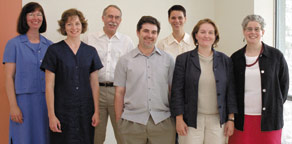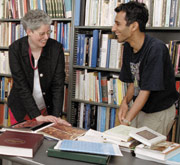

 |
|||
|
Page 1 | 2 A
Golden Year for the Department of Religion
Q:
What were the factors that led to the founding of Oberlin's Department
of Religion? Q:
How was it beleaguered? Q: Why? Richman: In the beginning, it was Holbrook versus the seminary and the philosophy department. The Oberlin School of Theology thought him too secular because he was willing to take seriously the criticisms of religion made by Marx, Freud, and others. In contrast, the philosophy department believed that he was teaching about "faiths" and felt that such study could not be rigorous or carried out according to the highest standards of logic and reason. Holbrook wanted to create a department that would have a central role in teaching the humanities at Oberlin. He yearned to teach religions in the way that other departments taught history, philosophy, or literature: as a history of human creativity – the ways in which various communities created systems of meaning and moral reasoning. It called for approaching religious texts and traditions not as repositories of "theological" knowledge or correctness, but as attempts to come to terms with the religious dimension of human existence. In the classroom, religious texts and traditions were subjected to empathetic, yet critical analysis, so that undergraduates could understand the experience of religion from a variety of perspectives. I suppose that viewpoint doesn't seem at all radical now, but it was very radical in the 1950s. Q: So what happened? Richman: Holbrook was a smart, determined, and spunky man, as well as an extremely effective teacher. His courses–everything from Jonathan Edwards to Karl Barth to Martin Buber to Kierkegaard–became legendary on campus. Students simply had to take his most renowned class, Modern Religious Thought (known affectionately as MRT) to get the best out of Oberlin. He pushed us to consider the philosophical implications of each viewpoint we studied. It was a very demanding course. In fact, there was a famous piece of graffiti on campus: "God took MRT, but only got a B." Holbrook filled the biggest lecture hall on campus every year. Q: You were a religion major in the early 1970s. What was it like then? Richman:
From the current perspective of someone who did her graduate work
on religious traditions of India, what I find most amazing is that
we had two full-time, tenure-track people teaching Asian religions.
Daniel Overmeyer, who recently retired from the University of British
Columbia, taught Chinese and Japanese religion, while Larry Shinn,
now president of Berea College, taught Indian religion and Islam. Q: What's happening in the department now? Richman: In the department's early years, most of the struggles revolved around ensuring that the major religions of the world were central to our curriculum. In addition to teaching Judaism, Christianity, and Asian religions, we worked hard to gain a faculty position in Islam more than a decade ago. Meanwhile, the study of religion as a field was becoming more and more sophisticated about understanding the varieties of lived experience within a single religious tradition, so it was exciting when we were able to add a position in African American religious experience in the United States. Last year, we received a tenure-track position in the field of women and religion after more than a decade of requesting it. Now we want to pay attention to religions as trans- national systems, such as Buddhism in Asia and North America, and Islam in the Middle East and Indonesia, and teach about how religious traditions exert reciprocal influences on each other. Our faculty explores both constructive and historical religious materials and also the dimensions of religious experience, such as art, ritual, patterns of daily life, architecture, and clothing. Only by continually expanding and rethinking approaches can a discipline remain alive. (Q&A with Paula Richman is reprinted with permission of http://www.aarweb.org, 2002) The
Department of Religion has created a fund for lectures and student
projects in honor of its 50th anniversary. Contributions can be
sent to the Department of Religion Faculty and Student Support Endowed
Fund, c/o Developmental Resources, Bosworth 4, 50 W. Lorain Street,
Oberlin, OH 44074. |
|
back to top |
 The
Department of Religion at Oberlin celebrated its 50th anniversary
in 2001-02, as 1951 marked the official break of religious studies
from the School of Theology. The year-long commemoration featured
lectures and presentations by faculty and alumni, several of which
focused on the department's growth over the past five decades.
Today, the department has 10 full-time faculty members and 35 to
40 majors in each graduating class. Courses and faculty research
span the major religious traditions of the world.
The
Department of Religion at Oberlin celebrated its 50th anniversary
in 2001-02, as 1951 marked the official break of religious studies
from the School of Theology. The year-long commemoration featured
lectures and presentations by faculty and alumni, several of which
focused on the department's growth over the past five decades.
Today, the department has 10 full-time faculty members and 35 to
40 majors in each graduating class. Courses and faculty research
span the major religious traditions of the world. 